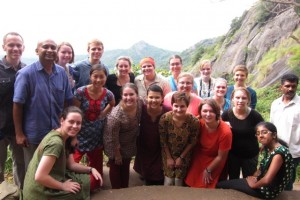
Fifteen of us sat with our legs crossed and huddled in the corner of a classroom, intently listening to the translation of a children’s meeting that was taking place..
“What are your human rights?” the facilitator asked a group of 25 middle-school aged students. One student after another rattled off basic human rights—the right to live, the right to education, the right to freedom—the list went on. Then, the students proceeded to discuss plans of action for campus improvements. One student suggested a garden as a means to provide healthy food. Another student added that it would also reduce carbon emissions. The garden was agreed upon and a letter was drafted for the school’s superintendent. I sat with my peers, absolutely astounded by the level of civic engagement we had just witnessed.
The meeting itself was a part of the Child Rights and Education Advocacy (CREA) program, an initiative of the Indian NGO and our host for the semester, Visthar. Since September, my peers and I have been studying social justice, peace, and development in India on a program run jointly by Gustavus and Concordia College.
Our studies include field visits, panels, lectures, and the more traditionally academic readings, assignments, and papers. The topics are often heavy—child labor, sweatshops, gender-based violence, etc.—and sometimes it feels as if there are no solutions in sight. We talk about the nitty-gritty structural causes of oppression and every situation seems tied up in a mess of injustice. It seems hopeless. But then I think of that CREA meeting. They are doing something right. There is hope for the rest of us.
The cliché “one person can make a difference” is true. CREA was inspired by the story of one girl who mobilized her classmates to demand their right to a free lunch at school (a right guaranteed by the Indian government). Having gone to her principal alone with the demand, she was sent away, but when she returned with all of her classmates, the lunch was reinstated. One girl served as a catalyst for change, and with a community behind her she succeeded.
Sometimes the semester is too overwhelming. Sometimes there seems to be so much sadness and anger within me that I am baffled by the “peace” part of the “social justice, peace, and development” moniker . But it is in community, again, that levity , joy, and peace are achieved.
Earlier in the semester, we drove into the heart of Bangalore, waded through crowded streets lined with women selling garlands of flowers and found ourselves in the heart of a large throng of people heading towards the Cathedral. It was the St. Mary’s Festival, and the city seemed to pour her heart out among the saffron-clad masses entering the church. Festivals are commonplace in India—the city stops for one day everyweek, children are home from school, and communities gather at banana-leaf plates to share a meal. These are the days that the city exudes happiness, so potent that it brings peace once again to my mind.